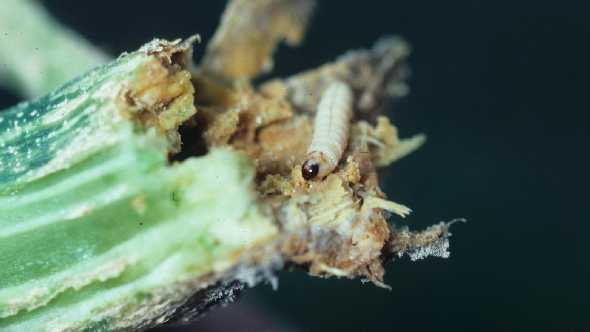Vigilance A Must To Squelch Squash Vine Borer
Crops Affected
The squash vine borer’s (Melittia cucurbitae Harris) range is restricted to the genus Cucurbita. It attacks both cultivated and wild cucurbits, but prefers species with large hollow stems to those with narrow stems. It is a major pest of summer squash and pumpkin, but a minor pest of cucumber, watermelon, and cantaloupe.

Photo by Gerald Holmes
Identification
The squash vine borer has been growing in economic importance with the expansion of cucurbit production in the U.S.
The adult squash vine borer resembles a wasp. The front wings appear metallic green to black. The hind wings lack scales, making them look clear. The abdomen is covered with orange to reddish hairs, punctuated with black dots. Females are larger and less colorful than males, with wider abdomens.
Unlike most moth species, which are active at night, adults are active during the day and can be observed feeding on nectar.
Eggs are small, dark to reddish brown, and ovoid, but slightly flattened in shape.
The larvae [pictured] are white with a darkened head capsule. Newly emerged larvae are tapered on the posterior end and covered with numerous large hairs. As the larva matures, it develops a dark thoracic shield and loses its tapered shape and hairy appearance.
Larvae tunnel into vines to feed. Feeding destroys vascular tissue and interrupts the flow of water and nutrients causing sudden localized wilting of the affected plants, usually observed during the middle of the day when temperatures rise, while the surrounding uninfested plants look healthy.
Inspection of infested plants may reveal an entry hole where the larva entered the plant surrounded by green frass. Dissecting the infested plants will reveal the squash borer larvae.
Feeding damage also predisposes the host plant to infection by plant pathogens.
Survival And Spread
The insect is native to North America and is distributed throughout the eastern U.S., southeastern Canada, and into Mexico. Eggs are laid singly on the lower part of the main stem of the host plant, as well as on leaf stalks, leaves, fruit buds, and into soil near plants. Females can produce 150 to 200 eggs in their lifetime. Newly emerged larvae burrow into vines, feeding on plant tissue. The larvae go through four instars in four to six weeks. The late instar larvae drop to the ground and burrow into the soil to pupate. The pupae complete development in 14 to 30 days.
Management Methods
Field sanitation is important to reduce the population density of borers the following season in fields with known infestation.
In some cases, planting dates can be staggered to allow crops to escape periods of heavy oviposition. Row covers also may help reduce egg laying.
Chemicals are the main method of control. Application must be done early to target larvae before they burrow into the vines. Once the larvae have tunneled into the vines, they cannot be reached by most insecticides.
Consult UF/IFAS recommendations for currently labeled insecticides for squash vine borer management in Florida cucurbits.










